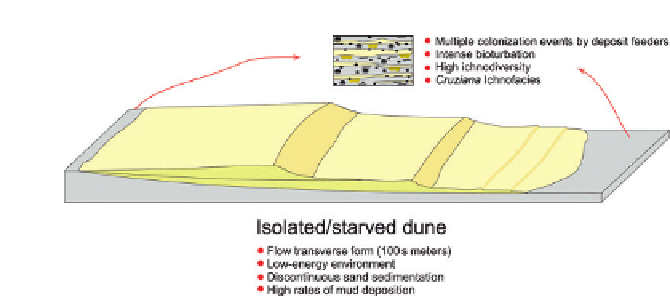Environmental Engineering Reference
In-Depth Information
FIGURE 14
Integrated sedimentological and ichnological model for isolated dune patches.
3.4 Isolated Dune Patches
Isolated dune patches occur in sand-starved areas of the shelf affected by tidal
currents under conditions of very low sediment supply (
Figs. 1 and 14
). They
typically develop during transgressions when shallow-water sands are redistrib-
uted toward the open shelf. This type of deposit is characterized by lenticular,
medium- to thick-bedded, low-angle compound cross-stratified packages
(
Fig. 15
A). Sigmoidal-shaped reactivation surfaces truncating the foresets are
common and grade laterally into intensively bioturbated, very thin- to thin-
bedded, ripple cross-laminated sandstone and mudstone displaying lenticular
bedding.
The sandy cross-stratified portions of the isolated dune patches are generally
not bioturbated, probably because of the high mud contents in the water column,
which may have prevented the establishment of the typical suspension-feeding
faunas adapted to relatively high-energy settings. However, the interfingering
muddy deposits typically contain a high diversity of trace fossils characteristic
of the archetypal
Cruziana
Ichnofacies. The trace-fossil fauna consists of
deposit-feeder trace fossils produced by both arthropods (e.g.,
Cruziana
,
Diplichnites
, and
Rusophycus
) and worms (e.g.,
Helminthopsis
,
Palaeophycus,
Phycodes
,
Planolites
,
Teichichnus
, and
Trichophycus
;
Fig. 15
B-E). The high
ichnodiversity and degree of bioturbation reflect the existence of continuous
colonization windows in mud-dominated low-energy zones of the inner shelf
(
Desjardins et al., 2012a
).
3.5 Tidal Bars
Bars are longer-lived sand bodies than subaqueous dunes (
Dalrymple and
Rhodes, 1995
). They include flow-transverse, flow-oblique, and longitudinally
oriented sand bodies, commonly having dunes superimposed on them. Tidal
bars are typically developed within distributary channels, along delta fronts
and in the outer parts of estuaries (
Dalrymple and Choi, 2007
), but do not occur
on the shelf proper because, in the offshore, tidal currents are not constrained by
geomorphological features. As in the case of tidal sand ridges, the migration of






Search WWH ::

Custom Search